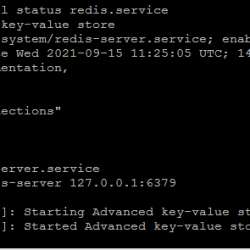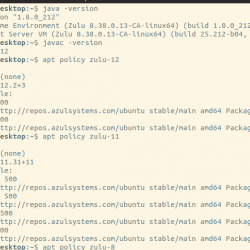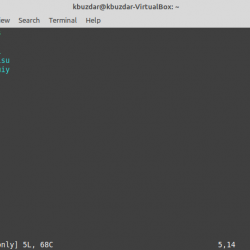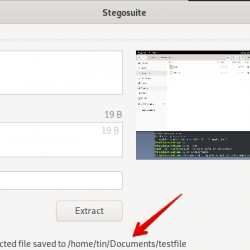通常,我们使用 ‘正常运行时间’ 命令来查找 Linux 系统或服务器已经运行了多长时间。 uptime 命令将为我们提供详细信息,例如当前时间、系统运行了多长时间、当前登录的用户数以及过去 1、5 和 15 分钟的系统负载平均值。 今天,我偶然发现了一个类似的实用程序,名为 正常运行时间, uptime 命令的替代方法。 Tuptime 是一个命令行实用程序 Python 报告 Linux 系统的历史和统计实时时间,在重新启动之间保持它。 它就像正常运行时间,但显示更有趣的输出。 在本指南中,我们将了解如何使用 Tuptime 实用程序查找 Linux 系统的正常运行时间。
在继续之前,让我给您举几个例子来使用“uptime”命令查找系统正常运行时间。
如果您在没有任何参数的情况下运行 uptime 命令;
$ uptime
您将看到如下所示的输出。
09:53:21 up 18 min, 1 user, load average: 0.01, 0.03, 0.06
这里,
- 09:53:21 – 当前时间,
- 最多 18 分钟 – 总正常运行时间,
- 1 位用户 – 当前登录用户的数量,
- 平均负载:0.01、0.03、0.06 – 过去 5、10 和 15 分钟的平均系统负载。
要仅显示总正常运行时间,请运行:
$ uptime -p
或者,
$ uptime --pretty
要显示系统启动的日期和时间,请运行:
$ uptime --s
或者,
$ uptime --since
如您所见,Uptime 只有两个选项(虽然这已经足够了)。
与 Uptime 命令相比,Tuptime 实用程序列出了以下附加详细信息:
- 从您安装 tuptime 实用程序之日起的总系统正常运行时间,
- 系统启动和关闭的总数,
- 正确或错误地关闭的总次数,
- 系统正常运行时间和停机时间计数器的百分比,
- 最大/最短/平均正常运行时间,
- 最大/最短/平均停机时间,
- 当前正常运行时间。
内容
安装 Tuptime
Tuptime 可在 金子, 所以它可以安装在 Arch Linux 及其变体上,使用如下的任何 AUR 助手。
$ yay -S tuptime
在 Debian、Ubuntu、Linux Mint 上:
$ sudo apt-get install tuptime
确保您已启用 [Universe] Ubuntu 及其衍生版本上的存储库,用于安装 tuptime。
Universe 可以使用以下命令启用:
$ sudo add-apt-repository universe
在其他 Linux 发行版上,使用以下命令 git 克隆 Tuptime 存储库:
$ git clone https://github.com/rfrail3/tuptime.git
例如,将“tuptime”二进制文件复制到您的 $PATH “/usr/local/bin/”:
$ sudo cp tuptime/src/tuptime /usr/local/bin/tuptime
最后,使其可执行:
$ sudo chmod ugo+x /usr/local/bin/tuptime
使用 Tuptime 查找 Linux 系统正常运行时间详细信息
要查看 Linux 系统的正常运行时间详细信息,只需运行:
$ tuptime
样本输出:
System startups: 1 since 07:24:35 AM 01/20/2020 System shutdowns: 0 ok - 0 bad System uptime: 100.0 % - 15 minutes and 49 seconds System downtime: 0.0 % - 0 seconds System life: 15 minutes and 49 seconds Largest uptime: 15 minutes and 49 seconds from 07:24:35 AM 01/20/2020 Shortest uptime: 15 minutes and 49 seconds from 07:24:35 AM 01/20/2020 Average uptime: 15 minutes and 49 seconds Largest downtime: 0 seconds Shortest downtime: 0 seconds Average downtime: 0 seconds Current uptime: 15 minutes and 49 seconds since 07:24:35 AM 01/20/2020
与传统的 Uptime 命令不同,Tuptime 将从安装之日起跟踪系统重新启动和关闭。 今天,我将它安装在我的 Ubuntu 服务器上并重新启动了两次系统。 Tuptime 跟踪所有系统启动/关闭,并以易于理解的方式呈现这些信息。
看看下面的输出。
$ tuptime System startups: 3 since 07:24:35 AM 01/20/2020 System shutdowns: 2 ok <- 0 bad System uptime: 43.18 % - 1 hour, 0 minutes and 27 seconds System downtime: 56.82 % - 1 hour, 19 minutes and 32 seconds System life: 2 hours, 19 minutes and 59 seconds Largest uptime: 35 minutes and 1 second from 07:41:00 AM 01/20/2020 Shortest uptime: 9 minutes and 20 seconds from 09:35:14 AM 01/20/2020 Average uptime: 20 minutes and 9 seconds Largest downtime: 1 hour, 19 minutes and 13 seconds from 08:16:01 AM 01/20/2020 Shortest downtime: 19 seconds from 07:40:41 AM 01/20/2020 Average downtime: 39 minutes and 46 seconds Current uptime: 9 minutes and 20 seconds since 09:35:14 AM 01/20/2020
看? 系统启动和关闭计数、总正常运行时间/停机时间平均正常运行时间/停机时间详细信息会相应更新。 默认的 uptime 命令不会跟踪此类详细信息。
正常运行时间选项
Tuptime 提供了一些有用的选项来格式化输出。
在表格列视图中显示输出
显示系统正常运行时间 表格列 格式,使用 -t 旗帜。
$ tuptime -t No. Startup Date Uptime Shutdown Date End Downtime 1 07:24:35 AM 01/20/2020 16 minutes and 6 seconds 07:40:41 AM 01/20/2020 OK 19 seconds 2 07:41:00 AM 01/20/2020 35 minutes and 1 second 08:16:01 AM 01/20/2020 OK 1 hour, 19 minutes and 13 seconds 3 09:35:14 AM 01/20/2020 2 hours, 57 minutes and 58 seconds
列表显示
同样,我们可以将输出显示为 列表显示 和 -l 旗帜。
$ tuptime -l Startup: 1 at 07:24:35 AM 01/20/2020 Uptime: 16 minutes and 6 seconds Shutdown: OK at 07:40:41 AM 01/20/2020 Downtime: 19 seconds Startup: 2 at 07:41:00 AM 01/20/2020 Uptime: 35 minutes and 1 second Shutdown: OK at 08:16:01 AM 01/20/2020 Downtime: 1 hour, 19 minutes and 13 seconds Startup: 3 at 09:35:14 AM 01/20/2020 Uptime: 3 hours, 0 minutes and 42 seconds
添加内核详细信息
我们甚至可以 添加内核信息 输出使用 -k 旗帜。
$ tuptime -k System startups: 3 since 07:24:35 AM 01/20/2020 System shutdowns: 2 ok <- 0 bad System uptime: 74.54 % - 3 hours, 52 minutes and 54 seconds System downtime: 25.46 % - 1 hour, 19 minutes and 32 seconds System life: 5 hours, 12 minutes and 26 seconds System kernels: 1 Largest uptime: 3 hours, 1 minute and 47 seconds from 09:35:14 AM 01/20/2020 ...with kernel: Linux-4.15.0-74-generic-x86_64-with-Ubuntu-18.04-bionic Shortest uptime: 16 minutes and 6 seconds from 07:24:35 AM 01/20/2020 ...with kernel: Linux-4.15.0-74-generic-x86_64-with-Ubuntu-18.04-bionic Average uptime: 1 hour, 17 minutes and 38 seconds Largest downtime: 1 hour, 19 minutes and 13 seconds from 08:16:01 AM 01/20/2020 ...with kernel: Linux-4.15.0-74-generic-x86_64-with-Ubuntu-18.04-bionic Shortest downtime: 19 seconds from 07:40:41 AM 01/20/2020 ...with kernel: Linux-4.15.0-74-generic-x86_64-with-Ubuntu-18.04-bionic Average downtime: 39 minutes and 46 seconds Current uptime: 3 hours, 1 minute and 47 seconds since 09:35:14 AM 01/20/2020 ...with kernel: Linux-4.15.0-74-generic-x86_64-with-Ubuntu-18.04-bionic
更改日期样式
也可以更改默认的人类可读日期样式和 以秒为单位的打印时间 和 时代的日期.
为此,请使用 -s 旗帜。
$ tuptime -s System startups: 3 since 1579505075 System shutdowns: 2 ok <- 0 bad System uptime: 74.77 % - 14140.49 System downtime: 25.23 % - 4772.32 System life: 18912.81 Largest uptime: 11073.81 from 1579512914 Shortest uptime: 965.97 from 1579505075 Average uptime: 4713.5 Largest downtime: 4753.29 from 1579508161 Shortest downtime: 19.03 from 1579506041 Average downtime: 2386.16 Current uptime: 11073.81 since 1579512914
更改日期格式
默认情况下,Tuptime 将根据您的系统区域设置打印详细信息。 但是,您可以 更改日期格式 根据您的喜好使用 -d 像下面这样的标志。
$ tuptime -d '%H:%M:%S %m-%d-%Y' System startups: 3 since 07:24:35 01-20-2020 System shutdowns: 2 ok <- 0 bad System uptime: 74.89 % - 3 hours, 57 minutes and 15 seconds System downtime: 25.11 % - 1 hour, 19 minutes and 32 seconds System life: 5 hours, 16 minutes and 47 seconds Largest uptime: 3 hours, 6 minutes and 8 seconds from 09:35:14 01-20-2020 Shortest uptime: 16 minutes and 6 seconds from 07:24:35 01-20-2020 Average uptime: 1 hour, 19 minutes and 5 seconds Largest downtime: 1 hour, 19 minutes and 13 seconds from 08:16:01 01-20-2020 Shortest downtime: 19 seconds from 07:40:41 01-20-2020 Average downtime: 39 minutes and 46 seconds
以 CSV 格式显示输出
如果需要,您也可以以 CSV 格式打印输出。
$ tuptime --csv "System startups","3","since","07:24:35 AM 01/20/2020" "System shutdowns","2","ok","<-","0","bad" "System uptime","75.2 %","-","4 hours, 1 minute and 10 seconds" "System downtime","24.8 %","-","1 hour, 19 minutes and 32 seconds" "System life","5 hours, 20 minutes and 43 seconds" "Largest uptime","3 hours, 10 minutes and 4 seconds","from","09:35:14 AM 01/20/2020" "Shortest uptime","16 minutes and 6 seconds","from","07:24:35 AM 01/20/2020" "Average uptime","1 hour, 20 minutes and 23 seconds" "Largest downtime","1 hour, 19 minutes and 13 seconds","from","08:16:01 AM 01/20/2020" "Shortest downtime","19 seconds","from","07:40:41 AM 01/20/2020" "Average downtime","39 minutes and 46 seconds" "Current uptime","3 hours, 10 minutes and 4 seconds","since","09:35:14 AM 01/20/2020"
一年前的显示输出
如果您的系统多年未运行,则此选项可以使 Linux 系统从一年前开始正常运行。
$ tuptime --tsince -31557600
可以在手册页中找到更多详细信息。
$ man uptime
$ man tuptime
建议阅读:
- 如何使用 Uptimed 监控 Linux 系统正常运行时间
- 如何在 Linux 中快速监控多台主机
- 如何找出一个进程在 Linux 中运行了多长时间
资源:
- Tuptime GitHub 存储库
感谢您的光临!
帮助我们帮助您:
- 订阅我们的电子邮件通讯: 立即注册
- 支持 OSTechNix: 通过贝宝捐款
- 下载免费的电子书和视频: TradePub 上的 OSTechNix
- 联系我们: 红迪网 | Facebook | 推特 | 领英 | RSS订阅
祝你有美好的一天!!
CLILinux 命令Linux uptimePythonTuptimeUptime



















